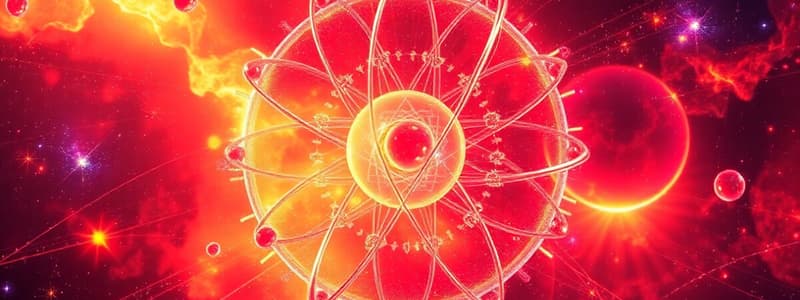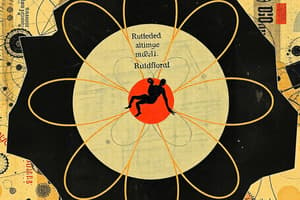Podcast
Questions and Answers
Rutherford's scattering experiment primarily challenged which aspect of the prevailing atomic model?
Rutherford's scattering experiment primarily challenged which aspect of the prevailing atomic model?
- The existence of electrons
- The overall neutrality of the atom
- The nature of the positive charge distribution (correct)
- The presence of a nucleus
Which observation from Rutherford's gold foil experiment led to the nuclear model of the atom?
Which observation from Rutherford's gold foil experiment led to the nuclear model of the atom?
- The complete absorption of some alpha particles
- A small fraction of alpha particles being significantly deflected (correct)
- Some alpha particles being slightly deflected
- Most alpha particles passing straight through the foil
Bohr’s refinement of the atomic model primarily addressed which of the following?
Bohr’s refinement of the atomic model primarily addressed which of the following?
- The existence of isotopes
- The arrangement of electrons (correct)
- The behavior of neutrons
- The nature of the nucleus
The discovery of the neutron contributed to the current atomic model in which of the following ways?
The discovery of the neutron contributed to the current atomic model in which of the following ways?
Rutherford’s study of radioactive decay contributed primarily to the understanding of what concept?
Rutherford’s study of radioactive decay contributed primarily to the understanding of what concept?
According to Rutherford’s model, what occupies the majority of an atom’s volume?
According to Rutherford’s model, what occupies the majority of an atom’s volume?
What was the primary flaw Thomson's plum pudding model?
What was the primary flaw Thomson's plum pudding model?
If Rutherford hadn't started his work, which of these concepts or models would still fit the evidence available at that point?
If Rutherford hadn't started his work, which of these concepts or models would still fit the evidence available at that point?
What concept did Bohr introduce that refined Rutherford's model?
What concept did Bohr introduce that refined Rutherford's model?
The naming of Rutherfordium exemplifies which aspect of scientific development?
The naming of Rutherfordium exemplifies which aspect of scientific development?
Flashcards
Rutherford's Experiment
Rutherford's Experiment
An experiment where Rutherford fired particles at thin atomic layers, leading to discoveries about atomic structure.
Atomic Nucleus
Atomic Nucleus
A small, dense center of an atom containing protons and neutrons.
Plum Pudding Model
Plum Pudding Model
An early atomic model by Thomson suggesting electrons are embedded in a positive cloud.
Rutherford's Model
Rutherford's Model
Signup and view all the flashcards
Fixed Energy Levels
Fixed Energy Levels
Signup and view all the flashcards
Proton
Proton
Signup and view all the flashcards
Neutron
Neutron
Signup and view all the flashcards
Radioactive Decay
Radioactive Decay
Signup and view all the flashcards
Half-Life
Half-Life
Signup and view all the flashcards
Rutherfordium
Rutherfordium
Signup and view all the flashcards
Study Notes
Rutherford's Atomic Model
- Rutherford's experiments showed atoms are mostly empty space with a concentrated, positively charged nucleus
- Particles were fired at a thin gold foil, most passed through, some deflected, and some bounced back
- This suggested a dense, positive center (nucleus) in the atom
Atomic Disintegration
- Atoms become smaller when they release particles
- Radiation is a byproduct of this disintegration process
- Radioactive materials have different disintegration rates (half-lives) that can be predicted
Atomic Model Development
- Thomson's "plum pudding" model: diffuse cloud of positive charge with electrons embedded
- Rutherford's model likened to a miniature solar system: mostly empty space, with electrons orbiting a tiny, central nucleus
Discovery of the Proton
- Rutherford found that nitrogen and other elements emitted hydrogen nuclei when bombarded with alpha particles
- Hydrogen nucleus (proton) is a fundamental building block for all elements
- The proton carries a positive charge
Discovery of the Neutron
- The neutron was identified in 1932 by James Chadwick
- Neutrons have a neutral charge and reside in the nucleus alongside protons
Atomic Structure Summary
- Atoms consist of a nucleus containing protons (positive charge) and neutrons (neutral charge)
- Electrons orbit the nucleus in different energy levels
Importance of Rutherford's Work (Quotes)
- "The changes in question are different ... from any that have been before dealt with in chemistry." - Ernest Rutherford, 1902
Studying That Suits You
Use AI to generate personalized quizzes and flashcards to suit your learning preferences.




